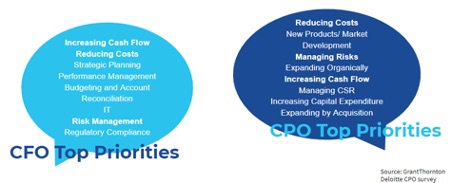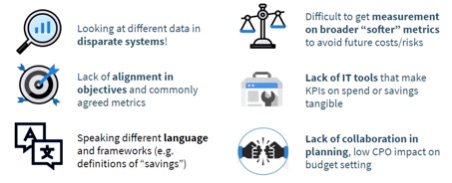In this two-part blog series, we’ll take a look at how to better position organizations in order to improve business continuity and resilience. Part 1 looks at the current state of collaboration between procurement and finance, and what these two teams can start doing to improve workflow, efficiency and bottom-line impact.
Let’s face it. Even now that we are forced to work from home (and actually pretty grateful to be able to in most cases), when we did all work in the same building, there was no guarantee of seamless collaboration or effective communication with our colleagues, was there?
Take Finance and Procurement teams, for example. It’s evident that there are common threads of interest that both CFOs and CPOs deem as important for the coming year. It will be highly likely that Risk Management and effective ways of working remotely for both teams jump up a few spots for next year!

Even before the COVID-19 crisis, both leaders ranked reducing costs, managing risk and increasing cash flow in their top 10 priorities. All three points will be pretty critical in effective recovery from the impacts of Corona, on our businesses and working ways of life.
Despite having these common goals at heart, why is that Procurement and Finance teams are just not that well aligned? According to AT Kearney and CIPS report; “Building a Bolder Legacy”, it was reported that Within the CFO and finance community, 71% report that Procurement lags most or all other functions in terms of rigor and depth of performance tracking!
Furthermore, about 60% of CFOs see less than 50% of the procurement reported benefits realized, or even worse, that they do not believe procurement has a clue what is actually realized.
Ouch!
After doing some digging, I think you can really pin down the reasons for this apparent discord, to several deficiencies when it comes to these teams effectively collaborating.
Let’s take a closer look at why procurement and finance teams are often not well aligned...

The main issues stem from these teams, and their leaders, looking at different data, speaking a different language in operational frameworks, and more often than not, suffering from a serious lack of company-wide agreement on what constitutes successful performance measurement in these focus areas!
There is often no visible link between where the CFO ultimately sets the strategy, and how overall performance measurement is disseminated down to a functional level. So there’s no clear link between purchasing performance and financial reporting. Purchasing performance also often covers “softer” metrics that a CFO may not see the value in, and there is certainly a lack of effective tools to automatically collect metric data, and show how the metrics they do have, impact each other.
A resulting lack of faith in results can lead to hesitation for CFOs to include CPOs in the planning phase. Therefore CPOs have a minimal impact on savings target and budget generation. This, in turn, makes it even more difficult for CPOs to deliver on a plan that they haven’t been involved in creating!
The good news is that these are not new challenges, and we can overcome them. And the truth is we are all going to have to get better at collaboration if we are going to succeed in our new remote working environments. Collaboration can no longer be taken for granted as an osmotic process, it must be formalized and spread over multiple defined channels. Data, most importantly, must be fluidly shared and commonly visible for us to work together.
Let’s focus on some specific areas and work out practical steps to overcome the challenges!
Let’s Consider Savings
We will undoubtedly, as both procurement and finance professionals, be asked to review and unearth new ways to recoup any losses suffered by our business during this time. Of course, there are several ways of capturing and defining savings and often these differ for the two teams. Let’s start with a sourcing project.
As a procurement professional, you set about working on savings against LPP (or PPV). Say you put the goods out to tender, find three quotes, the cheapest bringing an identified saving of $100k, you negotiate with your preferred supplier and settle on $80k in contracted savings.
Say then the usage forecast is wrong, or a global pandemic occurs, and you end up buying less. Or there is major leakage and people don’t actually buy from the contract you spent ages negotiating. Your lovely savings will disappear, or you end up breaking even. If the budget is set based on last year’s expenditure, and you don't come in with a bottom-line savings against budget, your CFO sees all of this as saving neutral! Argh!
What do you do about it? Define, agree, capture, review:
- Get in early with planning, ensuring CPOs are actively involved in budget and savings plan setting.
- Align procurement metrics to financial goals and make sure they are visible.
- Build clear KPIs into your Source to Pay platform - the more automated the process of collecting these performance results, the better!
- Minimize savings leakage with automated workflow, particularly between sourcing and contract management and your procurement process. So you can directly influence what people buy via the use of catalogs linked to negotiated contracts!
- Consider tapping into Group Procurement Organisations (GPOs) for improved purchasing power.
If you’re not using a cloud-based strategic sourcing tool to assist in running your savings projects, Hackett thinks you can save between 5-8% on every new dollar put through an eSourcing tool. It certainly keeps all your documents accessible in the cloud, and makes supplier management through the process easier to manage from home!










